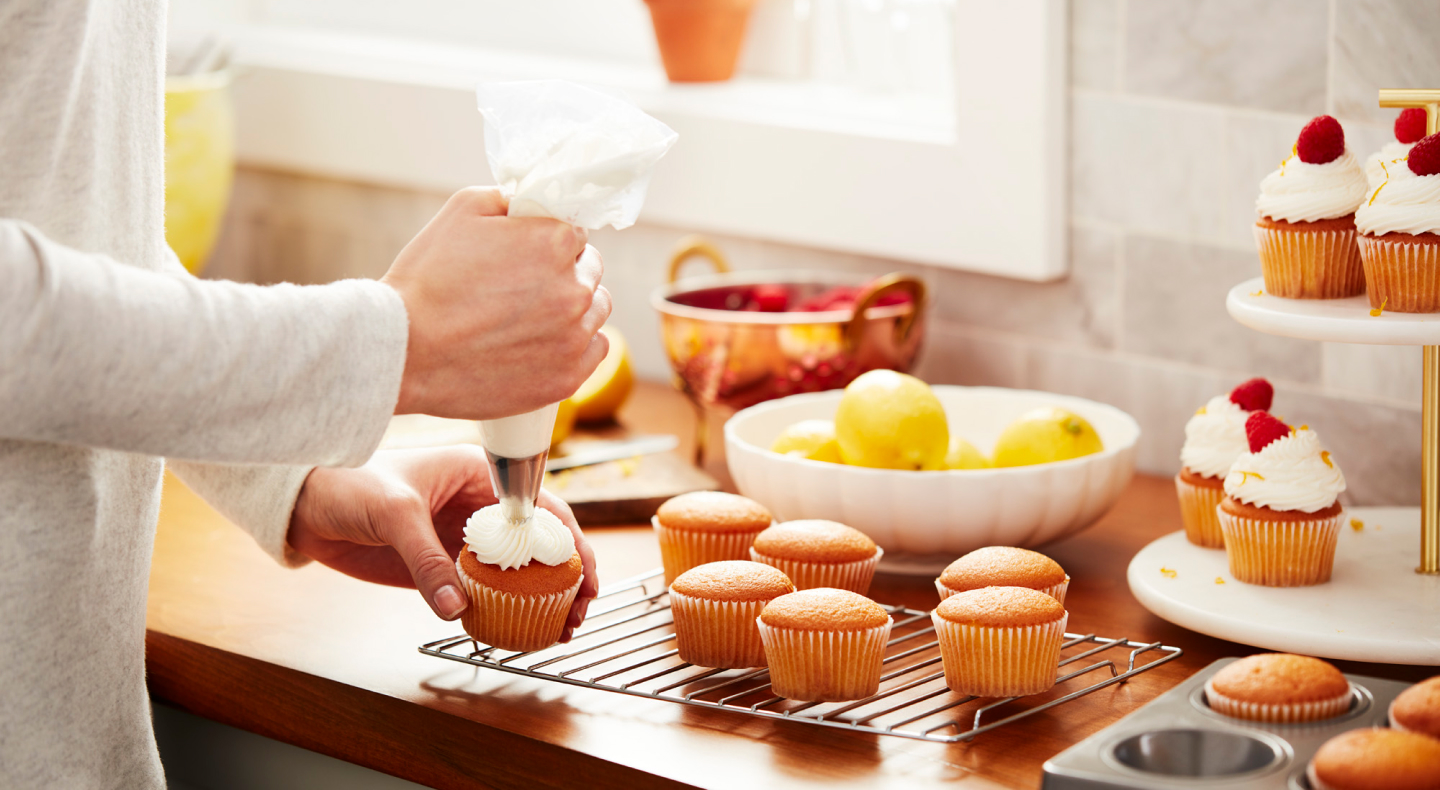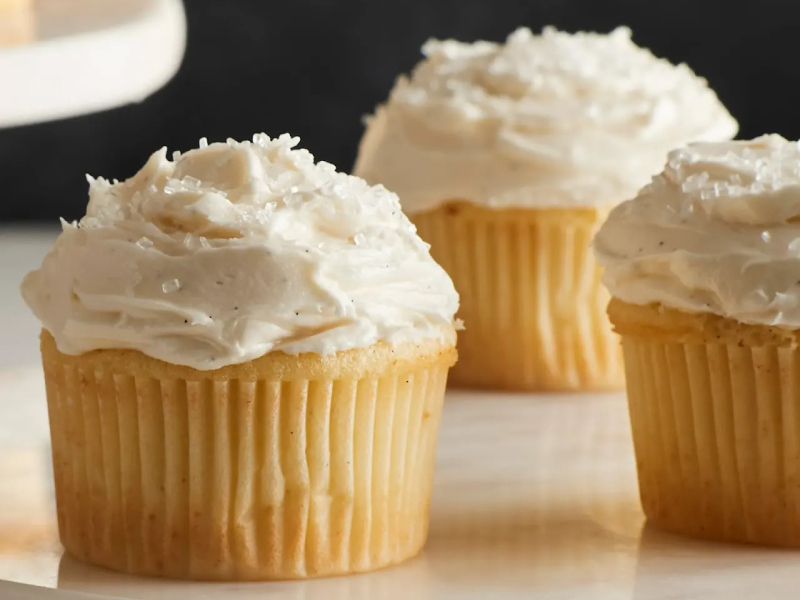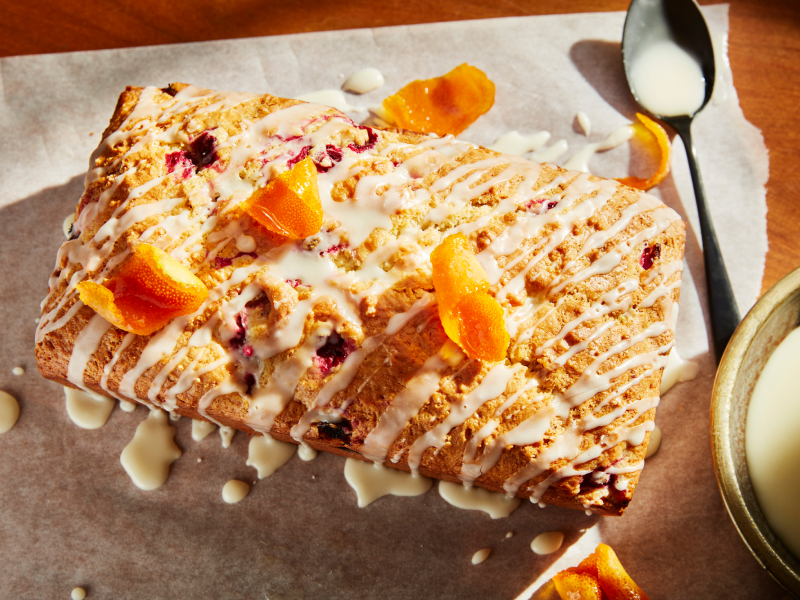
KEY DIFFERENCES BETWEEN FROSTING, ICING AND GLAZE
Frosting, icing and glaze are often essential elements in enhancing and embellishing a variety of baked goods. Although sometimes the terms frosting, icing and glaze are used interchangeably, they employ different ingredients and techniques to achieve a variety of flavors, textures and looks. Considered by many to be the piéce de résistance of a cake, cupcake or other baked treat, it’s important to have a good grasp of these sweet toppings to help create crave-worthy and beautiful results.


WHAT ARE THE DIFFERENCES BETWEEN FROSTING, ICING AND GLAZE?
The simplest way to differentiate between frosting vs icing vs glaze is consistency. Frosting is the thickest of these confections and is ideal for spreading or piping on cakes, cupcakes and cookies. Icing is a little thinner than frosting and is often poured or piped over coffee cakes, pound cakes, doughnuts and cookies—and it usually hardens when it dries. Glaze is the thinnest and most fluid of the three, and it will set but won’t harden as much as icing.
WHAT ARE THE DIFFERENT TYPES OF FROSTING, ICING AND GLAZE?
There are variations of frosting, icing and glaze with a wide range of flavors and effects.
Ganache is a popular, creamy form of icing. Royal icing hardens to a glossy finish which is great for decorating cookies and adding decorative details to other baked goods. There are also a variety of glazes to help create a culinary wow factor. Mirror glazes in particular are trending thanks to their show-stopping reflective beauty.
Buttercream, cream cheese and whipped cream are well-known frostings beloved for their taste and texture, and within buttercream alone, there are many variations that deliver different levels of silkiness, spreadability and richness.

1. FROSTING
There is a wide range of ways to create delicious types of frosting that are ideal for decorating and spreading on layer cakes, cupcakes and more. Made with a base of fat—like butter, shortening, cream cheese, cream or egg yolks—and creamed with sugars, fruits, purées, chocolate, extracts and/or spices, frostings are fun to make and easy to personalize.
BUTTERCREAM FROSTING
American buttercream is a classic and versatile frosting recipe that should be in every baker’s arsenal. It’s made by creaming together butter, confectioner’s sugar, a pinch of salt, milk or heavy whipping cream, vanilla and any other desired flavorings. Fluffy, spreadable and pipeable, this frosting is popular for good reason.
The frosting for this Vanilla Ombre Cake turns a delicious vanilla cake into a festive celebration cake with three graduating shades of buttercream. The cake and frosting come together easily with a little food coloring and a KitchenAid® stand mixer. Replace the food coloring with natural food dyes made from colorful produce, like beets, for natural color and a little extra goodness.
Many countries across the globe have their own version of buttercream frosting. The Italians and Swiss incorporate egg whites for light, airy meringue buttercreams. The French use egg yolks for a rich, silky confection and German buttercream includes pastry cream for a slightly less sweet version of the frosting.
This Mascarpone Buttercream Frosting recipe will give your cakes and cupcakes a delicate shift in taste. It replaces some of the butter with mascarpone for a creamy, ever so slightly nutty lift. Use your KitchenAid® hand mixer to cream together this delicious concoction.
CREAM CHEESE FROSTING
Cream cheese brings a hint of tang and is a delicious topping for cakes with autumnal flavors—such as pumpkin, sweet potato, carrot and zucchini. Of course, it's also a classic pairing for red velvet cakes or cupcakes too. Put a delicious twist on a dark, rich chocolate cupcake with Dulce de Leche Cream Cheese Frosting. The dulce de leche will help give your cream cheese frosting a rich, toffee flavor that balances well with the tanginess of the cream cheese and the sharpness of the dark chocolate.

2. ICING
Icing, which is thinner than frosting, is typically made with a base of powdered sugar combined with a liquid like milk, cream, juice or egg whites. It can be spread or poured on desserts and dries to a harder consistency than frosting. Drip cakes are on-trend desserts where you can create a pretty “drippy” look by pouring—or dripping—contrasting icing colors on a cake frosted with buttercream.
GANACHE
Ganache is a rich, delicious version of icing that’s typically made by pouring warm cream over chocolate. After the chocolate begins to melt, the cream and chocolate are mixed together until completely smooth. The ganache is pourable when it’s slightly cooled, but it will solidify a bit and become spreadable the longer it sits. The cooled ganache can also be whipped into a light, airy confection ideal for fillings.
This Buttermilk Strawberry Bundt Cake is iced with a ganache made with white chocolate, sweetened condensed milk and strawberry jam for a decadent pink topping on a delicate buttermilk cake.
ROYAL ICING
Royal icing is made by mixing powdered sugar and extracts with egg whites and then whipping it until the desired consistency is reached. This white icing can also be tinted with food coloring. This is the icing most used for decorating sugar cookies or adding fine details to cakes. It hardens as it dries for a smooth, glossy finish.

3. GLAZE
Typically made with confectioner’s sugar and milk, water or juices, glazes are a thinner form of icing that can be flavored with all kinds of delicious additions and poured over cakes, scones, cookies and more.
This Pistachio Sour Cream Coffee Cake can be made with ease when you use your KitchenAid® food processor to grind the pistachios. The moist cake is finished with a classic glaze made with milk and confectioner’s sugar. Glazes and doughnuts are another winning combination. This recipe for Cornbread Doughnuts with Cranberry Glaze and Pecans marries confectioner’s sugar with a little cranberry sauce for a sweet/tart holiday-inspired glaze. For an elegant dinner party dessert, bittersweet chocolate, corn syrup and espresso powder are combined for a mouthwatering glaze on this Chocolate Chiffon Cake with Chocolate Mocha Glaze.
MIRROR GLAZE
The “it glaze” of the moment—the mirror glaze—creates a shiny, reflective topping to help make elegant cakes and entremets next-level gorgeous. The glaze is created by combining bloomed gelatin with sweetened condensed milk and usually white or dark chocolate. Sometimes additional flavorings are included. Creating a tie-dye or marbled look can be achieved by pouring a combination of tinted glazes on your cake.
FROSTING VS ICING VS GLAZE AT A GLANCE
|
|
FROSTING |
ICING |
GLAZE |
|---|---|---|---|
| TEXTURE | Fat based—thick, fluffy and opaque | Sugar based—thinner than frosting—smooth and glossy | Sugar based—thinnest, most fluid and most transparent |
| APPLICATIONS | Spreading, piping and filling layer cakes, cupcakes, cookies | Pouring, dripping and drizzling over baked goods—some variations, like royal icing, can be used in decorating | Pouring or spooning over baked goods |
| INGREDIENTS | Sugar, butter, whipped cream, cream cheese, flavorings and sometimes egg yolks or whites | Sugar, milk, juice, purées or water and sometimes egg whites | Sugar and liquids including juices, purées, sweetened condensed milk |
| TECHNIQUE | Creamed with a stand mixer or hand mixer and piped with a pastry bag—some variations, like Swiss meringue, require cooking | Mixed with a spoon, stand or hand mixer, may also be piped—some variations, like ganache, require cooking | Combined with a spoon, stand or hand mixer—some variations, like mirror glaze, require cooking |
WHAT FROSTING IS BEST FOR DECORATING CAKES?
Due to its high fat content, buttercream smooths and holds shapes well, making it the ideal frosting for creating rosettes, shells, stars, swags and more for elegant cake decorating. Certain buttercreams work better than others for decorating. American, Swiss and Italian are the most stable of the buttercreams. These frostings pipe well and easily smooth onto cakes. Made with pastry cream, German buttercream has a softer texture that usually needs refrigeration. Due to the egg yolks in French buttercream, this frosting is silkier and has a yellow tint, making it better suited for fillings as opposed to decorating.
If you’re going for a more fluid look—like a drip cake—or you want to create intricate details for your cake, you’ll want to decorate with icing rather than frosting.
HOW DO YOU DRIZZLE ICING AND GLAZE?
When you’ve put time and effort into baking something delicious,you don’t want to skimp on the finishing details. It’s fun to create a beautiful, polished dessert by drizzling icing or glaze on it before serving. It’s easy to do in a few steps with the right tools.

STEP 1: GATHER TOOLS
You’ll need spoons or a plastic bag for every color or flavor of icing/glaze you’re using. You’ll also need scissors and a baking sheet with a baking rack.

STEP 2: SET UP WORK STATION
Place the baked goods you want to drizzle on a baking rack set on a rimmed baking sheet.

STEP 3: PREPARE ICING/GLAZE BAG
Because it’s liquid, glaze works great for drizzling, but icing can work too if you thin it with a little extra liquid. Fill a large plastic bag with icing or glaze and snip the corner with your scissors. You’ll want to work quickly before the liquid drips out of the bag.

STEP 4: WORK IN A ZIGZAG PATTERN
Place the tip of the bag over the baked good and squeeze icing all the way around it in a zigzag pattern until your baked good is covered to your liking. Repeat with a second color or flavor (if using) and finish with any other optional garnishes—chopped nuts, crushed candies, sprinkles, etc.
You can also spoon your glaze or icing over your dessert for a more rustic drizzled finish.
ADDITIONAL TIPS FOR WORKING WITH FROSTING, ICING AND GLAZE
Here are a few important things to keep in mind to help ensure tasty frosted, iced and glazed baked goods:
Use the right tools. An offset spatula for spreading and a bench scraper for creating a smooth finish are key. Rotating cake stands can come in handy for intensive decorating. Use a wire whip to whip creams and egg whites and use a flat beater with your KitchenAid® stand mixer to blend sugars and fats. And of course, a good pastry bag and an assortment of tips can be a cake decorating game changer.
Keep it vegan. Create a delectable vegan version of traditional buttercream by creaming powdered sugar with plant-based butter, nut milk and flavored extract.
Your refrigerator is your friend. Allow plenty of time to cool your layers. If your cake is too warm, your frosting or icing might melt away, taking any artful piping with it. To help ensure it’s decoration-ready, pop your cake in the refrigerator for 30 minutes before frosting. Allow a frozen cake to thaw halfway before you begin embellishing.
Stabilize your cake. Try putting a little frosting in the center of the cake stand before placing your first layer of cake on top of it. This will help keep your cake stationary while you work.
Keep it clean. Tuck strips of parchment along the edges, beneath your cake when you’re decorating to help catch any extra powdered sugar or frosting and help keep your cake stand or platter pristine. Remove these pieces of parchment before presenting your cake.
Keep it clean with a crumb coat. To help prevent crumbs from peaking through your frosting, use an offset spatula to coat it with a very thin layer of frosting. Refrigerate the crumb-coated cake for 30 minutes before adding a final layer of frosting and any decorations.
- Pay attention to icing’s consistency. An icing for drizzling will need to be slightly more fluid than icing for piping, so you may want to adjust the consistency of your royal icing for drizzling vs piping. This is simple to do—just add a few drops of water until your desired consistency is achieved.


EXPLORE KITCHENAID® STAND MIXERS, ACCESSORIES AND ATTACHMENTS
A beautiful cake has the power to transform a good meal into an unforgettable occasion. Your kitchen creativity reaches the next level with a KitchenAid® stand mixer. Choose a stand mixer in the size and color that’s just right for you and the way you create. Enhance the style, personality and versatility of your mixer by customizing it with engravings, extra bowls and additional KitchenAid® accessories and KitchenAid® attachments, all sold separately.

